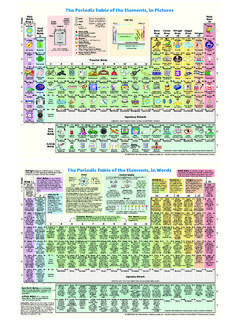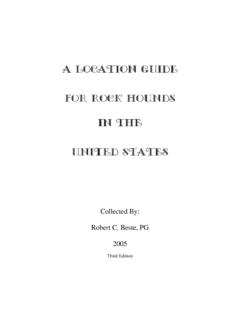Transcription of DIAMONDS AND ASSOCIATED HEAVY MINERALS …
1 Chapter 46 DIAMONDS AND ASSOCIATED HEAVY MINERALS INKIMBERLITE: A REVIEW OF KEY CONCEPTS ANDAPPLICATIONSTOM E. NOWICKIa, RORY O. MOOREa, JOHN J. GURNEYbAND MIKE C. BAUMGARTNERaaMineral Services Canada, 205-930 Harbourside Drive, North Vancouver, ,CanadabMineral Services South Africa, 42 Morningside, N Dabeni, Cape Town, South AfricaABSTRACTK imberlite, a variety of ultramafic volcanic and sub-volcanic rock, is the dominant source ofdiamonds worldwide. It is widely accepted that the majority of DIAMONDS are not formed withinthe kimberlite and much evidence points towards an ancient origin for most diamond in thedeep lithospheric keels of Archaean cratons. The kimberlites, therefore, are transporting agentsthat sample deep, occasionally diamond -bearing, mantle material and rapidly convey it tosurface. The dominant source rocks for diamond are highly depleted peridotite (harzburgiteor dunite) and high-pressure eclogite.
2 These are minor components of the mantle lithosphere,which is dominated by less-depleted peridotite (primarily lherzolite) and lesser amounts of non-diamondiferous eclogite. While other diamond sources are known, these rarely contributesignificantly to diamond populations in kimberlite . Despite the limited range of source lithologies, diamond population characteristics in any given kimberlite are typically highly complex andindicative of several distinct populations, most likely formed in discrete events occurring atdifferent times, ranging from the Archaean to the age of kimberlite addition to rare diamond , disaggregation of mantle rocks sampled by kimberlite yieldsrelatively large quantities of other mantle MINERALS , commonly referred to as kimberlitic indicatorminerals. From an exploration point of view, the most important indicator MINERALS are garnet,chromite, ilmenite, Cr-diopside and olivine.
3 Several of these MINERALS display diagnostic visualand compositional characteristics, making them ideal pathfinders for kimberlite . The morechemically resistant MINERALS (garnet, ilmenite and chromite) are particularly useful due to theirgreater ability to survive weathering in the surface environment. Thus, sampling of surfacematerials to recover kimberlitic indicator MINERALS and tracing these back to their source is a keycomponent of most diamond exploration in Sedimentology, Vol. 58, 1235 1267r2007 Elsevier All rights : 0070-4571/ (07)58046-51235 Studies of diamond inclusions and diamond -bearing xenoliths permit geochemical character-isation of diamond source materials and have led to major advances in the understanding of therelationship between diamond and its host rock in the :indicator- mineral ; exploration; geochemistry; peridotite; eclogite; garnet; chromite; ilmenite;clinopyroxene1. INTRODUCTIONK imberlite is an ultramafic, alkaline igneous rock of deep-seated origin that cancontain significant quantities of diamond (Mitchell, 1986).
4 It is by far the mostimportant primary source of these gems, accounting for more than 70% of worlddiamond production by value in 2003 (based on data inWillmott, 2004). The onlyother commercially significant primary diamond source is olivine lamproite, anultramafic, ultrapotassic rock similar in certain respects to kimberlite (Mitchell,1995). This rock type currently provides 5% by value ( 20% by weight) of worlddiamond production, with the balance of production deriving from secondarydeposits in alluvial and marine sediments. The development of laboratory processesto produce DIAMONDS (Bundy et al., 1973), and subsequent refinements that enablethe mass manufacture of a superior product for industrial purposes, has had a majoreffect on the world market for natural DIAMONDS which is now predominantly reliantfor revenue on the global jewellery has been apparent for some years that kimberlite and lamproite are merelytransporting agents carrying diamond from its source region in the upper mantle tothe crust.
5 Whether diamond remains at the end of the journey depends on whether itwas present in the mantle rocks sampled and disaggregated by the kimberlite and onwhether or not the DIAMONDS were preserved (Gurney, 1984). A very high-gradekimberlite or lamproite might contain 5 carats (1 carat g) of DIAMONDS pertonne of host rock, translating to a concentration of 1 part per proven diamond source rocks in the mantle are various types of peridotite(Dawson and Smith, 1975;McCallum and Eggler, 1976;Pokhilenko et al., 1977;Shee et al., 1982), certain high pressure eclogite assemblages ( ,Rickwood et al.,1969;Sobolev, 1974;Reid et al., 1976;Robinson et al., 1984) and closely associ-ated websterites ( ,Gurney, 1989), and the ultra-high pressure mineral majorite(Moore and Gurney, 1985). With the exception of majorite (a very rare associationbelieved to be sourced from the asthenosphere), these diamond -bearing sourcesoccur only in the deep portions of the thick lithosphere developed under Archaeancratons.
6 Thus, all known significantly diamondiferous kimberlites occur withinregions underlain by Archaean crust and/or derived from the diamond source rocks described above are present inall kimberlites with significant concentrations of diamond . However, even in highlydiamondiferous kimberlite , they are typically subordinate to ubiquitous mantle-derived MINERALS from rock types that do not have a clear association with addition, most kimberlite intrusions do not contain significant concentrations ofdiamond, indicating that diamond is rare and sporadically distributed even in itsoriginal source region within the 46: DIAMONDS and ASSOCIATED HEAVY MINERALS in Kimberlite1236 Mantle-derived MINERALS sampled and brought to surface by kimberlite (and othersimilar rock types) are typically referred to as kimberlitic indicator MINERALS . Themost important of these are garnet, ilmenite, chromite, Cr-diopside and (enstatite) is a key component of the lithospheric mantle but is highlyreactive with the kimberlite magma and is, therefore, commonly absent or onlypreserved in trace amounts (Seifert and Schreyer, 1968).
7 Similarly, omphaciticclinopyroxene, which makes up a significant proportion of mantle eclogite, is highlyunstable at low pressure and it typically breaks down on ascent to the surface. Thusenstatite and omphacite are rarely useful as kimberlitic indicator MINERALS . The othermantle-derived MINERALS are commonly present in significant concentrations in mostkimberlites and, even in highly diamondiferous bodies, are typically three or fourorders of magnitude more abundant than diamond . As a result, indicator mineralsprovide an invaluable exploration tool, firstly as pathfinder MINERALS for locatingkimberlites and, secondly, as indicators of the diamond potential of their this contribution, we review some important concepts relating to the originof diamond and its association with other mantle MINERALS . These concepts formthe basis for a tried and tested approach to the application of indicator mineralgeochemistry in kimberlite diamond : PETROLOGICAL ASSOCIATIONS AND Multiple diamond PopulationsIn both kimberlites and lamproites, DIAMONDS range in size from microcrystalssmaller than 50mm to macrocrystals occasionally over l cm in size.
8 It is clear that thefull diamond suite in any given deposit incorporates several overlapping populationswith diverse origins. Evidence for more than one population of eclogitic or peri-dotitic DIAMONDS has been presented for several localities (Moore and Gurney, 1985,1989;Deines et al., 1987;Otter and Gurney, 1989). In a study of DIAMONDS from thelow-grade Letseng La Terai locality in northern Lesotho,McDade and Harris (1999)detected 10 different diamond parageneses. Developing the same theme,Gurneyet al. (2004)have described widely disparate DIAMONDS recovered from variouskimberlites on the Slave Craton (Fig. 1). These include flat-faced sharp-edgedoctahedra, fibrous cubes, coated stones, DIAMONDS of various colours, cloudy stones,deformed crystals and extensively resorbed DIAMONDS . It has been suggested thatthese also have been produced by a number of different diamond -forming processesin the mantle. It is apparent, therefore, that DIAMONDS recovered from kimberlitegenerally reflect a variety of processes and most likely represent several differentdiamond Peridotite and Eclogite: Key diamond SourcesEvery diamond -bearing locality, for which a reasonable body of data exists, hasdiamonds of eclogitic and peridotitic paragenesis, as judged by mineral inclusionsin the DIAMONDS and often confirmed by the finding of diamond -bearing xenoliths2.
9 diamond : Petrological Associations and Genesis1237 Fig. 1. DIAMONDS from kimberlites in the Ekati property, Slave province, Canada. Thesediamonds were recovered from geographically closely ASSOCIATED kimberlites in the Slave cra-ton but are also broadly representative of DIAMONDS from kimberlite worldwide. Examples ofmost of these diamond types can be found in any given kimberlite of the Ekati property. (A)Colourless, flat-faced octahedra from Fox. (B) Colourless, flat-faced octahedron from Fox,showing a characteristic imperfectly developed crystal termination. (C) Light brown octahedrafrom Grizzly. (D) Colourless, step-faced octahedron from Koala. (E) Colourless contact-twinned octahedral (macles) from Fox. (F) Brown, step-faced octahedron from Misery. (G)Dark brown octahedron from Koala. (H) Fibrous-coated, flat-faced octahedron from Panda.(I) Remnant fibrous coat on surface of a flat-faced octahedron from Panda; the coat has beensufficiently resorbed at the edges and corners to reveal a colourless, gem-quality interior.
10 (J)Translucent lemon yellow cube from Sable. (K) Opaque, fibrous cubes from Grizzly. (L)Colourless cubo-octahedra from Piranha; the DIAMONDS have a translucent core and trans-parent rims. (M) Light brown, rounded resorbed diamond from Fox with relict octahedralsurfaces. (N) Colourless dodecahedron from Koala. (O) Light brown, rounded resorbed do-decahedron from Misery with well-developed curvilinear faces acquired during resorption. (P)Dark brown rutted and rounded dodecahedron from Misery. DIAMONDS in (A) through (G)have primary shapes and are expected to be old by analogy to other studies; (H) and (I) areprimary old DIAMONDS coated with young fibrous diamond ; (J) may be a Type Ib, very youngdiamond; (K) are young fibrous cubes; (L) are intermediate between (A) through (G) and (K);(L) through (O) are all resorbed forms of DIAMONDS anticipated to be old. [Reproduced fromGurney et al., (2004), Fig. 2, p. 29; permission by Elsevier, 2007.]






